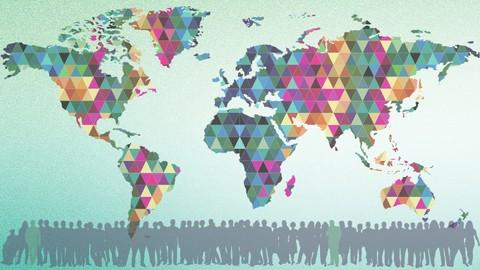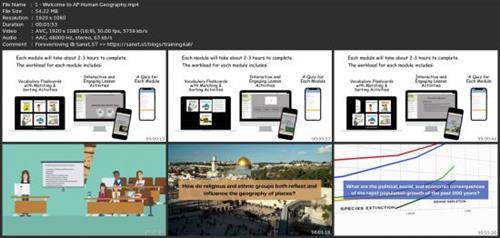Ap Human Geography
Published 10/2024
MP4 | Video: h264, 1920x1080 | Audio: AAC, 44.1 KHz
Language: English | Size: 1.57 GB | Duration: 1h 22m
An engaging AP exam prep and full online course that covers topics such as population, migration, culture, and more!
What you'll learn
Identify types of maps, the types of information presented in maps, and different kinds of spatial patterns and relationships portrayed in maps.
Identify different methods of geographic data collection.
Define scales of analysis used by geographers.
Describe different ways that geographers define regions.
Define methods geographers use to calculate population density.
Explain ways that geographers depict and analyze population composition.
Explain theories of population growth and decline.
Explain the causes and consequences of an aging population.
Explain how different causal factors encourage migration.
Describe types of forced and voluntary migration.
Explain how landscape features and land and resource use reflect cultural beliefs and identities.
Explain patterns and landscapes of language, religion, ethnicity, and gender.
Define the types of cultural diffusion.
Explain what factors lead to the diffusion of universalizing and ethnic religions.
For world political maps: Define the different types of political entities and identify a contemporary example of political entities.
Explain the processes that have shaped contemporary political geography.
Describe the concepts of political power and territoriality as used by geographers.
Define types of political boundaries used by geographers.
Explain how the concepts of centrifugal and centripetal forces apply at the state scale.
Explain the connection between physical geography and agricultural practices.
Identify different rural settlement patterns and methods of surveying rural settlements.
Identify major centers of domestication of plants and animals.
Explain how plants and animals diffused globally.
Explain the advances and impacts of the second agricultural revolution.
Explain the consequences of the Green Revolution on food supply and the environment in the developing world.
Explain how economic forces influence agricultural practices.
Describe how the von Thünen model is used to explain patterns of agricultural production at various scales.
Explain how agricultural practices have environmental and societal consequences.
Explain the processes that initiate and drive urbanization and suburbanization.
Explain the internal structure of cities using various models and theories.
Explain the effects of different urban design initiatives and practices.
Explain how the Industrial Revolution facilitated the growth and diffusion of industrialization.
Explain the spatial patterns of industrial sectors, production, and development.
Describe social and economic measures of development.
Explain how and to what extent changes in economic development have contributed to gender parity.
Explain different theories of economic and social development.
Explain how sustainability principles relate to and impact industrialization and spatial development.
Requirements
No prior experience or specific geographic knowledge is required to begin this course. All materials are explained clearly, making it accessible for a wide range of learners.
Description
Are you preparing for the AP Human Geography exam or looking to deepen your understanding of human geography concepts? This comprehensive course is designed for students who want to excel in AP Human Geography and beyond.In this course, you'll explore key topics such as:Population & Migration: Understand population growth, migration patterns, and demographic changes across the globe.Cultural Patterns: Dive into languages, religions, and cultural identities that shape human experiences.Urbanization & Development: Examine how cities grow and evolve and analyze economic systems and levels of development.Political Organization: Learn about the formation of countries, boundaries, and the impact of political systems on global relations.Agriculture & Rural Land Use: Explore farming practices and how food production impacts society and the environment.Key features of this course include:In-depth lessons that align with the College Board AP Human Geography curriculum. Exam-focused content to help you succeed on the AP examInteractive quizzes and assignments to test your knowledgeReal-world case studies that bring human geography concepts to lifePractice tests and review materials to help you master every unitWhether you're a homeschooler or lifelong learner this course will prepare you for both the AP exam and a deeper understanding of how geography shapes the world around us.+ People aged 18-21 can still take the official AP exam as long as they have not already started college. Please note that you will need to sign up for the official College Board AP Exam separately from this course.
Overview
Section 1: Introduction
Lecture 1 Welcome to AP Human Geography!
Section 2: Maps and Geospatial Technologies
Lecture 2 Maps and Geospatial Technologies
Lecture 3 Unit 1 Review
Section 3: Introduction to Population
Lecture 4 Introduction to Population
Section 4: ? The Demographic Transition Model
Lecture 5 The Demographic Transition Model
Section 5: Population Theories
Lecture 6 Population Theories
Section 6: Migration Part 1
Lecture 7 Migration Part 1
Lecture 8 Video: Crisis at the Border
Section 7: Migration Part 2
Lecture 9 Migration Part 2
Section 8: Migration Part 3
Lecture 10 Migration Part 3
Section 9: Culture Part 1
Lecture 11 Culture Part 1
Section 10: Culture Part 2
Lecture 12 Culture Part 2
Section 11: Language
Lecture 13 Language
Section 12: Religion
Lecture 14 Religion
Section 13: Ethnicity
Lecture 15 Ethnicity
Lecture 16 Apartheid South Africa
Lecture 17 What Qualifies as Genocide?
Section 14: Political Geography Part 1
Lecture 18 Political Geography Part 1
Section 15: Political Geography Part 2
Lecture 19 Political Geography Part 2
Section 16: Political Geography Part 3
Lecture 20 Political Geography Part 3
Section 17: Political Geography Review
Lecture 21 Political Geography Review
Section 18: Agriculture Part 1
Lecture 22 Agriculture Part 1
Section 19: Agriculture Part 2
Lecture 23 Agriculture Part 2
Section 20: Agriculture Part 3
Lecture 24 Agriculture Part 3
Section 21: Economic Development Part 1
Lecture 25 Economic Development Part 1
Section 22: Development Part 2
Lecture 26 Development Part 2
Section 23: Economic Development Part 3
Lecture 27 Economic Development Part 3
Lecture 28 The Industrial Revolution's Link to the 2nd Agricultural Revolution
Section 24: Energy & Resources
Lecture 29 Energy & Resources
Section 25: Urban Land-Use Part 1
Lecture 30 Urban Land-Use Part 1
Section 26: Urban Land-Use Part 2
Lecture 31 Urban Land-Use Part 2
Section 27: Urban Patterns & Processes Part 3
Lecture 32 Urban Patterns & Processes Part 3
Section 28: Urban Patterns & Processes Review
Lecture 33 Overview of Urban Geography
Primarily aimed at students preparing for the AP Human Geography exam, whether enrolled in a traditional classroom setting or studying independently.,Those who prefer to study at their own pace, with flexible access to the course materials and exam prep resources to accommodate different learning styles and schedules.,Parents and homeschool educators looking for a structured, high-quality curriculum to guide their learners through the essential topics of AP Human Geography.,Anyone with an interest in human geography and related subjects, who is looking to expand their understanding of population trends, urbanization, cultural landscapes, political geography, and more.
Screenshots
Say "Thank You"
rapidgator.net:
ddownload.com:Kod:https://rapidgator.net/file/bfa77d566b850d24d0e132b276ab4a2f/gkuzp.Ap.Human.Geography.part1.rar.html https://rapidgator.net/file/4271fcdbd02ebe19553bf9877f610d32/gkuzp.Ap.Human.Geography.part2.rar.html
Kod:https://ddownload.com/wmk00twifk16/gkuzp.Ap.Human.Geography.part1.rar https://ddownload.com/bdtmszpaslr2/gkuzp.Ap.Human.Geography.part2.rar
1 sonuçtan 1 ile 1 arası
Konu: Ap Human Geography
-
16.10.2024 #1Üye



- Üyelik tarihi
- 20.08.2016
- Mesajlar
- 145.639
- Konular
- 0
- Bölümü
- Bilgisayar
- Cinsiyet
- Kadın
- Tecrübe Puanı
- 154
Ap Human Geography
Konu Bilgileri
Users Browsing this Thread
Şu an 1 kullanıcı var. (0 üye ve 1 konuk)



 LinkBack URL
LinkBack URL About LinkBacks
About LinkBacks






 Alıntı
Alıntı
Konuyu Favori Sayfanıza Ekleyin